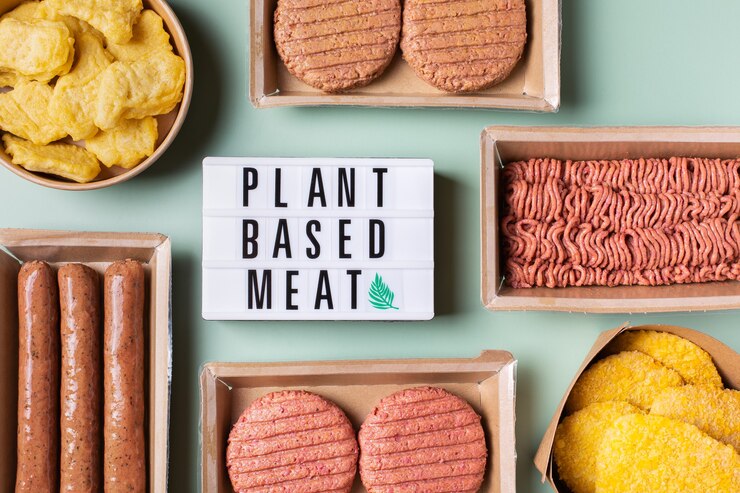Whole Food Plant-Based Meats are plant-based protein sources that mimic the texture and flavor of traditional meat. This guide explores a variety of options, from classic legumes like lentils and chickpeas to innovative meat alternatives like tempeh and seitan. We’ll delve into the nutritional benefits of these foods, discuss their role in a healthy diet, and provide tips for incorporating them into your meals.
Curious about the latest plant-based meat alternatives? Looking for healthy and delicious recipes? Whether you’re a seasoned plant-based eater or just starting your vegan journey, this article has everything you need. Discover the best whole food plant-based meats, explore their nutritional profiles, and learn how to prepare them in a variety of ways. Join the growing community of plant-based enthusiasts on Reddit and share your experiences.
A Shift Towards Whole Food Plant-Based Meats
In 2024, the shift towards whole food plant-based meats has gained significant momentum. This trend is driven by a growing awareness of the environmental and health benefits of reducing meat consumption.
According to the Good Food Institute, the plant-based food market in the U.S. alone is now worth $8.1 billion, with plant-based meat sales rising rapidly despite economic pressures. Consumers are increasingly opting for plant-based alternatives due to their lower environmental impact, as producing plant-based meats generates fewer greenhouse gases and requires less land and water compared to conventional meat production.
This trend is particularly important in the vegan world as it aligns with the core principles of veganism, which emphasize reducing harm to animals and promoting sustainability. Whole food plant-based meats offer a more natural and minimally processed alternative to traditional meat substitutes, making them more appealing to both vegans and non-vegans.
By choosing these products, consumers can enjoy the taste and texture of meat while contributing to a more sustainable and ethical food system. The increasing availability and variety of whole food plant-based meats are helping to make veganism more accessible and mainstream, further supporting the movement’s growth and impact.

Health Benefits: Whole Foods vs. Processed Options
| Feature | Whole Foods | Processed Foods |
| Nutrient Density | High in vitamins, minerals, fiber, and antioxidants | Lower in essential nutrients, often stripped during processing |
| Digestive Health | Promotes healthy gut bacteria due to fiber content | Can disrupt gut health with added sugars, unhealthy fats, and artificial additives |
| Weight Management | More satiating, leading to better appetite control | Often high in calories, unhealthy fats, and added sugars, contributing to weight gain |
| Chronic Disease Risk | Lower risk of heart disease, type 2 diabetes, and certain cancers | Increased risk of chronic diseases due to added sugars, unhealthy fats, and excessive sodium |
| Energy Levels | Sustained energy release due to complex carbohydrates and fiber | Short-term energy spikes followed by crashes due to simple sugars |
| Overall Health | Promotes overall well-being and longevity | Can negatively impact overall health and vitality |
Note: While some processed foods can be part of a balanced diet, excessive consumption of highly processed foods is linked to various health issues. Prioritizing whole foods is generally recommended for optimal health.
Innovative Whole Food Meat Alternatives
One of the most exciting developments in the plant-based food industry is the rise of innovative whole food meat alternatives. These options offer a delicious and sustainable way to enjoy meat-like flavors and textures without relying on highly processed ingredients.
Mushrooms
Mushrooms, with their diverse range of flavors and textures, have emerged as a versatile and nutritious meat alternative. Varieties like portobello, shiitake, and oyster mushrooms can be used to create a variety of meat-like dishes. Portobello mushrooms, for example, can be grilled or roasted to mimic the texture of steak, while shiitake mushrooms offer a rich, umami flavor that’s perfect for stir-fries and soups. Oyster mushrooms, with their delicate, seafood-like texture, can be used in dishes like pasta and risotto.
Walnuts
Walnuts are a powerhouse of nutrients, offering a unique blend of healthy fats, protein, and fiber. They are an excellent source of omega-3 fatty acids, particularly alpha-linolenic acid (ALA), which is essential for heart health and brain function. Additionally, walnuts are rich in antioxidants, which help protect cells from damage.
In terms of texture and taste, walnuts offer a satisfying crunch and a rich, nutty flavor. Their slightly oily texture makes them ideal for ground meat alternatives, such as walnut meatloaf or walnut burgers. The high fat content helps to bind the ingredients together and creates a meaty texture. The nutty flavor adds depth and complexity to dishes, making them a versatile ingredient in plant-based cooking.
Tempeh
Tempeh is a fermented soybean product that has gained popularity as a versatile and nutritious plant-based protein source. It is made by cooking soybeans and fermenting them with a mold culture, resulting in a dense, chewy texture and a slightly nutty flavor. Tempeh is a great source of protein, fiber, and various vitamins and minerals.
Tempeh’s versatility in cooking makes it a popular choice for both experienced and novice cooks. It can be marinated, fried, grilled, or baked, and it can be used in a wide range of dishes, from stir-fries and sandwiches to stews and casseroles. When cooked, tempeh develops a firm, meaty texture that can be easily crumbled or sliced. This makes it an excellent substitute for ground meat in dishes like tacos, burgers, and meatballs.
Legumes
Legumes, such as lentils, chickpeas, and black beans, are versatile and nutritious plant-based protein sources. They are packed with fiber, vitamins, and minerals, making them a healthy and sustainable alternative to meat. Lentils, for instance, are a great source of iron and protein, while chickpeas are high in fiber and antioxidants.
To achieve meat-like textures, legumes can be prepared in various ways. One popular method is to cook them until tender and then mash or blend them into a paste. This paste can be used to form patties, meatballs, or sausages. Another technique involves dehydrating legumes and grinding them into a fine powder, which can be used as a meat extender or a substitute for ground meat. Additionally, legumes can be fermented to develop a unique flavor profile and a firmer texture, as seen in tempeh.

Cooking Techniques for Whole Food Plant-Based Meats
Here are the cooking techniques you can try at home to have a whole food from plant-based meats:
Marinating and Seasoning Tips
Marinating plant-based meats can elevate their flavor and texture. A simple marinade of soy sauce, olive oil, garlic, and herbs can work wonders. For a more complex flavor profile, consider adding spices like cumin, paprika, or chili powder. Marinating for a few hours or overnight allows the flavors to penetrate deeply.
Cooking Methods for Optimal Texture
To achieve the best texture, consider the specific ingredient. For example, searing tempeh can create a crispy exterior and a tender interior. Roasting vegetables like portobello mushrooms can enhance their natural sweetness and juiciness. When cooking legumes, it’s essential to cook them until they are tender but not mushy.
Time-Saving Preparation Techniques
To save time in the kitchen, consider pre-cooking and freezing plant-based proteins. This can be especially helpful for legumes like lentils and chickpeas. Simply cook them until tender, drain, and store them in airtight containers in the freezer. When you’re ready to use them, thaw them and reheat them in a saucepan or microwave. Additionally, marinating ingredients in advance can save time during meal prep.
Nutritional Comparison
| Feature | Whole Food Plant-Based Meats | Processed Plant-Based Meats |
| Ingredients | Primarily whole, minimally processed plant-based foods like legumes, grains, nuts, and vegetables | Often contain highly processed ingredients, artificial additives, and isolated protein concentrates |
| Nutrient Profile | Rich in fiber, vitamins, minerals, and antioxidants | May be lower in fiber and higher in sodium, unhealthy fats, and added sugars |
| Environmental Impact | Generally more sustainable due to lower processing and resource use | May have a higher environmental impact due to intensive processing and ingredient sourcing |
| Health Benefits | Lower risk of chronic diseases, improved digestive health, and weight management | Potential health risks associated with excessive consumption of processed foods, including increased risk of chronic diseases |
| Texture and Flavor | Can vary widely depending on the specific ingredient and preparation method, but often has a more natural and earthy flavor | Can closely mimic the texture and flavor of meat, but may have a less natural taste and a more processed texture |
| Cost | Generally more affordable, especially when purchasing whole, unprocessed ingredients | Can be more expensive, particularly for branded, processed products |
Note: While both whole food plant-based meats and processed alternatives can be part of a healthy diet, prioritizing whole foods is generally recommended for optimal health and environmental sustainability.
Protein and other nutritional needs
To ensure adequate protein intake on a whole food plant-based diet, it’s important to include a variety of protein-rich foods in your meals. Legumes like lentils, chickpeas, and beans are excellent sources of plant-based protein. Additionally, grains like quinoa and whole wheat provide a good amount of protein.
Nuts and seeds, such as almonds, chia seeds, and hemp seeds, are also rich in protein and healthy fats. By combining these foods in meals and snacks, you can easily meet your daily protein needs. Furthermore, a whole food plant-based diet is rich in essential vitamins, minerals, and fiber, which contribute to overall health and well-being.
Environmental Impact
The sustainability of whole food plant-based meats has been a focal point of recent studies and research. A 2021 study found that plant-based patties have a 77% smaller climate change burden compared to beef patties, with significantly reduced land and water use, eutrophication, and acidification.
Additionally, life-cycle analyses suggest that plant-based meat alternatives have a lower environmental footprint than beef raised in feedlots, although the footprint can be higher than beef from well-managed pastures. This highlights the potential for plant-based meats to contribute to a more sustainable food system.
Moreover, the global plant-based meat market is projected to reach $14.9 billion by 2027, growing at a compound annual growth rate (CAGR) of 15% from 2020 to 2027. This growth is driven by increasing consumer awareness of the environmental and health benefits of plant-based diets. As more people adopt plant-based eating, the demand for sustainable food options continues to rise, further supporting the shift towards whole food plant-based meats.
Comparison to both animal-based meats and processed alternatives
| Feature | Animal-Based Meats | Processed Plant-Based Meats |
| Primary Ingredient | Animal flesh (beef, pork, chicken, etc.) | Highly processed plant-based proteins, often isolated and combined with additives |
| Environmental Impact | Significant environmental impact, including greenhouse gas emissions, deforestation, and water pollution | Can vary depending on production methods, but often involves significant processing and packaging |
| Health Benefits | Can be a good source of protein and other nutrients, but high consumption linked to various health risks | May contain added sugars, unhealthy fats, and artificial additives, potentially increasing health risks |
| Texture and Flavor | Diverse range of textures and flavors, but can be high in saturated fat and cholesterol | Can closely mimic the texture and flavor of meat, but may have a less natural taste and a more processed texture |
| Cost | Can be more expensive, particularly for high-quality, organic meats | Can be more expensive, particularly for branded, processed products |
This comparison highlights the unique advantages of whole food plant-based meats over both animal-based and processed plant-based options. While animal-based meats can provide essential nutrients, they often come with significant environmental and health concerns. Processed plant-based meats, while convenient, may compromise nutritional value and environmental sustainability. Whole food plant-based meats offer a more sustainable, healthier, and ethical alternative.
Challenges and Solutions
Introducing a plant-based diet to family members may require patience and creativity. Start by incorporating plant-based meals gradually, and focus on familiar flavors and textures. Involve family members in the cooking process to foster a sense of ownership and excitement. Highlight the health benefits and sustainability of a plant-based diet, and emphasize the delicious and satisfying nature of plant-based meals.
Dining out and traveling can pose challenges for plant-based eaters. However, with a little planning, it’s possible to enjoy delicious and nutritious meals. Research plant-based restaurants in your destination or look for vegetarian and vegan options on menus. If dining out isn’t an option, consider packing plant-based snacks and meals. Additionally, many hotels and accommodations now offer plant-based meal options.

FAQs
What are plant-based meats?
Plant-based meats are food products made from plant-based ingredients that mimic the taste, texture, and appearance of traditional meat. They are often used as a meat alternative in vegetarian and vegan diets.
What is whole food plant-based?
A whole food plant-based diet primarily consists of minimally processed plant-based foods like fruits, vegetables, whole grains, legumes, nuts, and seeds. It emphasizes whole, unprocessed foods over refined or processed ones.
Does a whole food plant-based diet include meat?
No, a whole food plant-based diet strictly excludes all animal products, including meat, poultry, fish, eggs, and dairy. It focuses solely on plant-based foods.
What are some examples of plant-based foods?
Plant-based foods include a wide variety of options such as fruits (apples, berries, bananas), vegetables (carrots, spinach, broccoli), whole grains (brown rice, quinoa, oats), legumes (beans, lentils, chickpeas), nuts (almonds, walnuts, cashews), and seeds (chia seeds, flaxseeds, sunflower seeds).
Final Thoughts
As the plant-based movement continues to gain momentum, whole food plant-based meats offer a sustainable, healthy, and delicious alternative to traditional meat products. By embracing these nutrient-dense, minimally processed foods, we can reduce our environmental impact, improve our health, and contribute to a more compassionate world.
Remember, the key to a successful plant-based diet is variety and creativity. Experiment with different ingredients, cooking techniques, and flavor combinations to discover your favorite plant-based meals. By making informed choices and incorporating whole food plant-based meats into your diet, you can enjoy a fulfilling and satisfying culinary experience.









